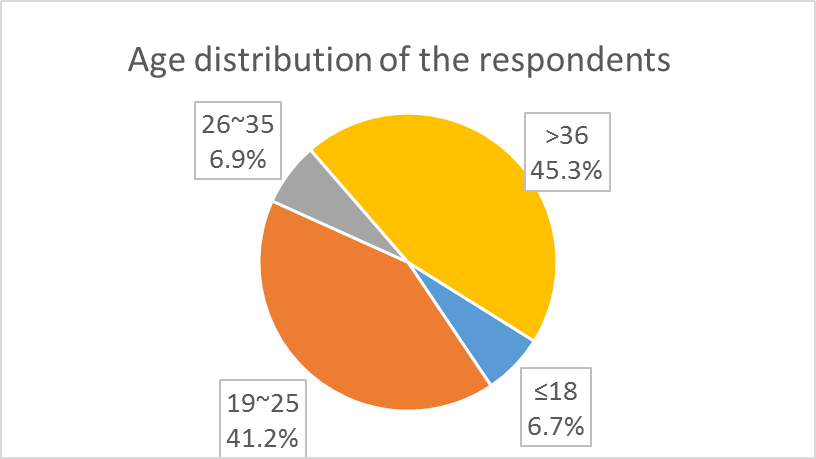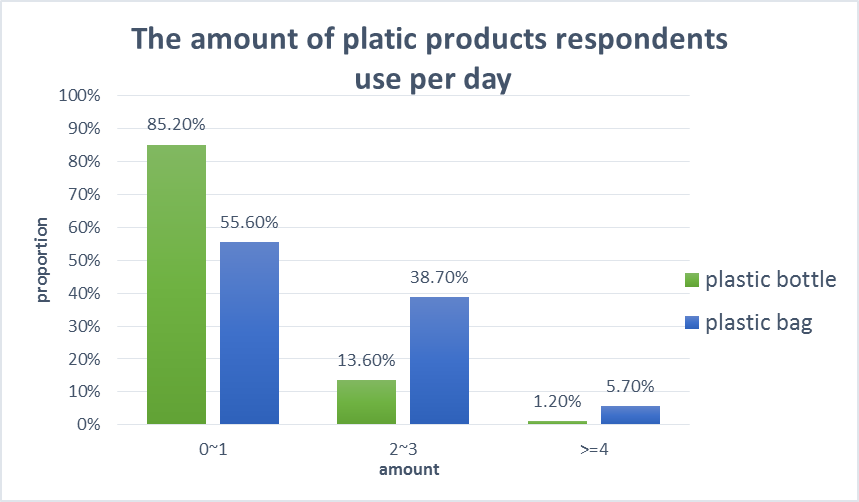Crepuscule (Talk | contribs) |
Crepuscule (Talk | contribs) |
||
| Line 382: | Line 382: | ||
<p class="data" style="color:#344525;font-size:20px"><h5>Basic information of the people being investigated: </h5>Totally 686 people filled this questionnaire from 9:00, July 22nd to 0:00, July 25th, of which 62.2% are female and 37.8% are male. The age of these people are mainly 19-25 and over 35, which respectively accounts for 41.2% and 45.3%. Most people (66.6%) have bachelor’s degree. 38.4% of people are engaged in education, research and engineering. Most of the people are from different province in China while a few of them are living abroad.<br/><br/> | <p class="data" style="color:#344525;font-size:20px"><h5>Basic information of the people being investigated: </h5>Totally 686 people filled this questionnaire from 9:00, July 22nd to 0:00, July 25th, of which 62.2% are female and 37.8% are male. The age of these people are mainly 19-25 and over 35, which respectively accounts for 41.2% and 45.3%. Most people (66.6%) have bachelor’s degree. 38.4% of people are engaged in education, research and engineering. Most of the people are from different province in China while a few of them are living abroad.<br/><br/> | ||
| + | |||
<div class="col-md-6 about-left wow fadeInLeft animated" data-wow-delay=".5s"> | <div class="col-md-6 about-left wow fadeInLeft animated" data-wow-delay=".5s"> | ||
| − | <img src="https://static.igem.org/mediawiki/2016/a/a9/T--Tianjin--gender.png" alt="" width:100%> | + | <img src="https://static.igem.org/mediawiki/2016/a/a9/T--Tianjin--gender.png" alt="" style="width:100%"> |
</div> | </div> | ||
| + | |||
<div class="col-md-6 about-right wow fadeInRight animated" data-wow-delay=".5s"> | <div class="col-md-6 about-right wow fadeInRight animated" data-wow-delay=".5s"> | ||
| − | <img src="https://static.igem.org/mediawiki/2016/8/85/T--Tianjin--age.png" alt="Gender" title="Gender" width:100%> | + | <img src="https://static.igem.org/mediawiki/2016/8/85/T--Tianjin--age.png" alt="Gender" title="Gender" style="width:100%"> |
</div> | </div> | ||
Revision as of 03:00, 3 October 2016
Our visit to the TEDA
green technology exhibition hall
Survey of the Uses of Plastic

" Plastic is one of the most widely used material in daily life for its low cost, low density, low electrical conductivity and easiness of processing. Since the first kind of plastic was found in 1907, we have lived with plastic for over a century. However, the white pollution caused by discarded plastic has raised more and more concern. Though governments in many places have passed law to restrict the use of plastic, the best solution toward this problem is to find out a easy, cheap and environmental friendly way to degrade the discarded plastic. Among the existing degrading way, the biodegradation of plastic is regarded as the most promising one. This questionnaire aims to investigate the daily use of plastic products and the attitude of people toward the biodegradation of plastic. "
P.S. Chinese and English versions of the questionnaire survey results
Summary for Our Questionnaire of the Uses of Plastic
Basic information of the people being investigated:
Totally 686 people filled this questionnaire from 9:00, July 22nd to 0:00, July 25th, of which 62.2% are female and 37.8% are male. The age of these people are mainly 19-25 and over 35, which respectively accounts for 41.2% and 45.3%. Most people (66.6%) have bachelor’s degree. 38.4% of people are engaged in education, research and engineering. Most of the people are from different province in China while a few of them are living abroad.

Analysis of the data received:
60.2% of people think that they usually feel the harm of the White Pollution in their daily life, only 2.9% of people never feel it.
55.8% of people show modest satisfaction toward the disposal of waste plastics in their living place, and 40.4% of people are totally unsatisfied to it. The people who are satisfied with it only account of 3.8%.
When asked what is the meaning of the number in the triangle printed on the plastic products, we are disappointed to find that only 28.1% of people selected the correct choice, which is “the number refers to the component of plastic”.

When it comes to the attitude toward the disposable plastic products, 73.9% of people think they can be allowed to use but should be strictly controlled and recycled. 23.2% of people are totally against the use of them. Only 2.9% of people are totally for the use of them.
Most (85.2%) of people use only 0-1 plastic bottle every day. Only 13.6% of people use 2-3 plastic bottles every day. People using 4 and more plastic bottles every day account for only 1.2%. The using of plastic bags every day is of few differences, the daily number of the plastic bags used is 0-1 for 55.6% of people, 2-3 for 38.7% of people and 4 and more for 5.7% of people.


When asked the way of disposing the used plastic products (one can select more than one choices), 74.5% of people selected “I will continue use it if I can”, 33.0% of people selected “I will throw it into the garbage can directly”, 1.2% of people selected “I will throw it everywhere”.

When asked whether the plastic products are able to be recycled, we are satisfied to find that 76.2% of people selected the correct choice, which is “some can while others cannot”.

when investigated the situation of the received education about the effects of plastics to the environment, 46.4% of people only received it in textbooks, 36.3% of people received it in both textbooks and the propaganda of the community, 17.3% of people never received this kind of education at all.

When asked the proper ways to control the White Pollution efficiently (one can select more than one choices), most people think that using environmental friendly substitutes is reasonable, which account for 81.9%, followed by the people who think that searching for a effective way to degrade plastics by scientists is a good idea, which account for 72.9%. Besides are people who think conduct propaganda in the community to encourage residents to recycle plastics (67.5%) and governments introduce relevant laws (65.5%).

When asked the proper ways to dispose the waste plastics (one can select more than one choices), 89.9% of people selected “Biodegradation of microorganisms” and 71.6% of people selected “Chemical degradation and obtain chemical raw materials”. A few people selected “Incineration together” and “Dumping in the soil”, which respectively account for 6.6% and 3.6%.

When asked whether you have heard the biodegradation of plastics, 24.1% of people never heard it, 55.7% of people heard it in the popular science articles online, 15.9% of them have learned the relevant knowledge at school and only 4.4% of people know the plastic biodegradation systematically.

When asked the opinion of the prospect of plastic biodegradation, 51.3% of people show confidences to it, 47.2% of people think it is not easy to achieve, and only 1.5% of people think it is impossible.

The last compulsive question is “When someday scientists successfully find a effective microorganism to biodegrade the plastics using the modern biological technology, do you agree to spread it to the environment?” The result is 46.5% of people agree and 47.2% of people are neutral, only 6.3% of people disagree.































